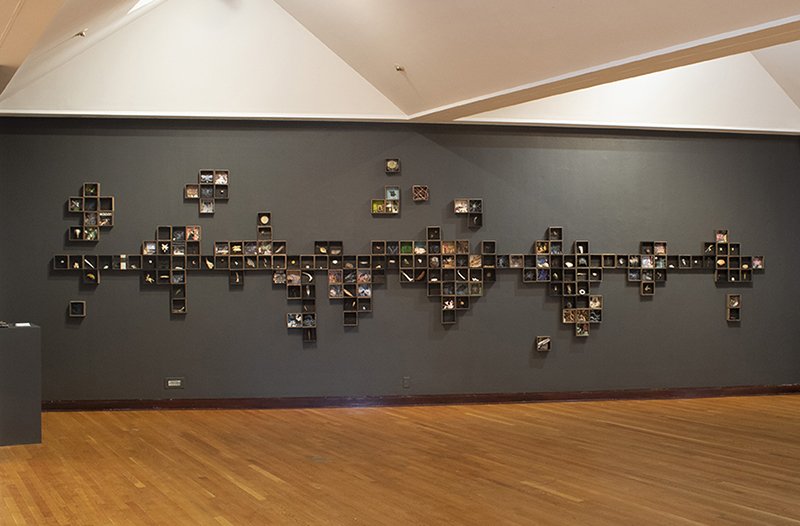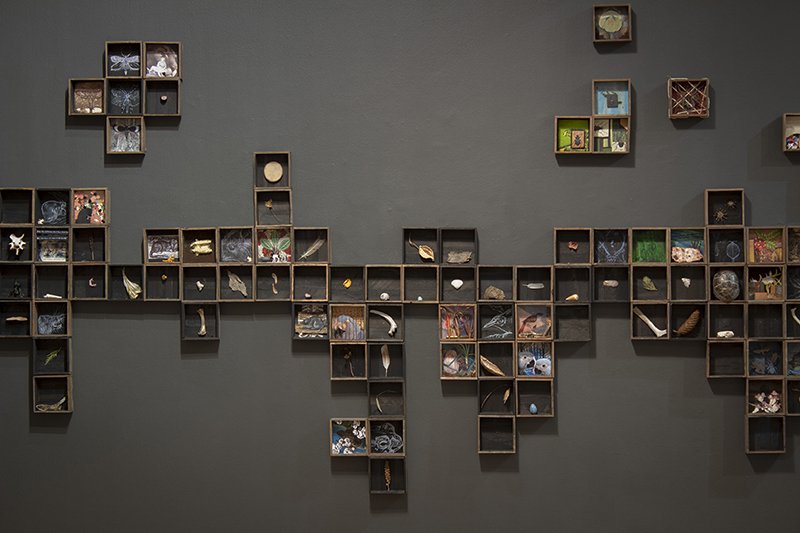
Solastalgia
Reclaimed pinewood & mixed media
Dimensions vary // 2019
Solastalgia n. A concept developed to give greater meaning and clarity to environmentally induced distress. As opposed to nostalgia—the melancholia or homesickness experienced by individuals when separated from a loved home—solastalgia is the distress that is produced by environmental change impacting people while they are directly connected to their home environment.1
Solastalgia is the culmination of my research and personal reflections on the Anthropocene era. During my time investigating what it means to be living in this troubled world, the overarching themes of grief, memory, reverence, and celebration have surfaced again and again.
The installation is a memorial to the estimated 150-200 species that go extinct every day on Earth. 86% of the species on land and 91% in the ocean have yet to be scientifically identified and named. The memorial commemorates all of the species officially classified in 2018 as “Extinct,” “Extinct in the Wild,” or “Critically Endangered (Possibly Extinct in the Wild)” in reports from various organizations such as The International Union for Conservation of Nature and BirdLife International. By using this classifying system I implicate the human hand in the rapid rate of extinction while highlighting the anthropocentric desire to officially record the name and status of a species in order to document and recognize its loss. There are 74 species represented on the wall, leaving 124 blank spaces for the unknown species that never came into contact with the scientific community.
The use of natural objects, textbook illustrations, and gridded display structure recall Western anthropogenic impulses to classify, study, and organize the chaos of “nature,” much like the cabinet of curiosities of the 17th century. While I wish for this monument to be a vessel for holding grief, I would also like it to be a source of reflection on the causes of the Sixth Extinction—the global mass die-off of species we are currently witnessing. Since Aristotle, Western thought has maintained the position that man is superior to all other forms of life. Therefore, many of us view the capture, use, and extermination of other species as a distant and scientific endeavor. My intention with Solastalgia is to reimagine our domination-based relationship with other species and consider how it would be reconfigured if we were able to pay the same amount of respect to our fellow creatures as we do to our own dead.
The form and structure of Solastalgia are informed by the día de los muertos altars I encountered while living in Oaxaca, Mexico, as well as elements from natural history museological displays. I was struck by the deep reverence the Mexican altars inspired in me and wanted to capture that sentiment in my own work. Each reclaimed pine box is hand-built and includes collage, painting, and found objects that refer to the intricate life of the species as well as the contributing factors to its death. In this way, the installation is a lament of loss as well as a celebration of life.
The accompanying Guide to Grief in the Anthropocene is a pictorial synthesis of scientific information from the IUCN reports and my own personal reactions. It includes ways of coping with such overwhelming information in a regenerative way. This book is not only an aid for inner-healing through grief and acceptance, but also an inspiration for action once that healing has occurred.







